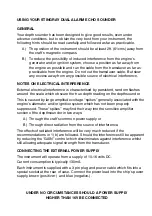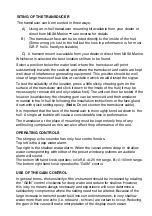
USING YOUR STINGRAY DUAL ALARM ECHO SOUNDER
GENERAL
Your depth sounder has been designed to give good results, even under
adverse conditions, but to obtain the very best from your instrument, the
following hints should be read carefully and followed as far as practicable.
A)
B)
The position of the instrument should be at least 2ft. (61cms) away from
the craft’s magnetic compass.
To reduce the possibility of induced interference from the engine’s
generator and/or ignition system, choose a position as far away from
the engine as possible and run the cable from the transducer as far as
practicable from the engine. Do not cut the transducer cable. But stow
any excess away from any possible source of electrical interference.
NOTES ON ELECTRICAL INTERFERENCE
External electrical interference is characterised by persistent, random flashes
around the scale which obscure the true depth reading on the depthsounder.
This is caused by large amplitude voltage “spikes” generally associated with the
engine’s alternator and/or ignition system which has not been properly
suppressed. These “spikes” may find their way into the sensitive amplifier
section of the depthsounder in two ways:
A)
B)
Through the craft’s common power supply or
Through direct radiation from the source of interference.
The effects of radiated interference will be very much reduced if the
recommendations in 1 (b) are followed. Should the interference still be apparent
try reducing the “GAIN” control which discriminates against interference whilst
still allowing adequate signal strength from the transducer.
CONNECTING THE EXTERNAL POWER SUPPLY
The instrument will operate from a supply of 10-16 volts DC.
Current consumption is typically 130mA.
Each instrument is supplied with a 3 pin plug and power cable which fits into a
special socket at the rear of case. Connect the power lead into the ship’s power
supply, brown (p) and blue (negative-).
UNDER NO CIRCUMSTANCES SHOULD A POWER SUPPLY
HIGHER THAN 16V BE CONNECTED


























